稀有濒危植物贵州红山茶种群结构及数量动态变化的研究
唐凤 邹天才 杨乃坤 胡光平 刘海燕
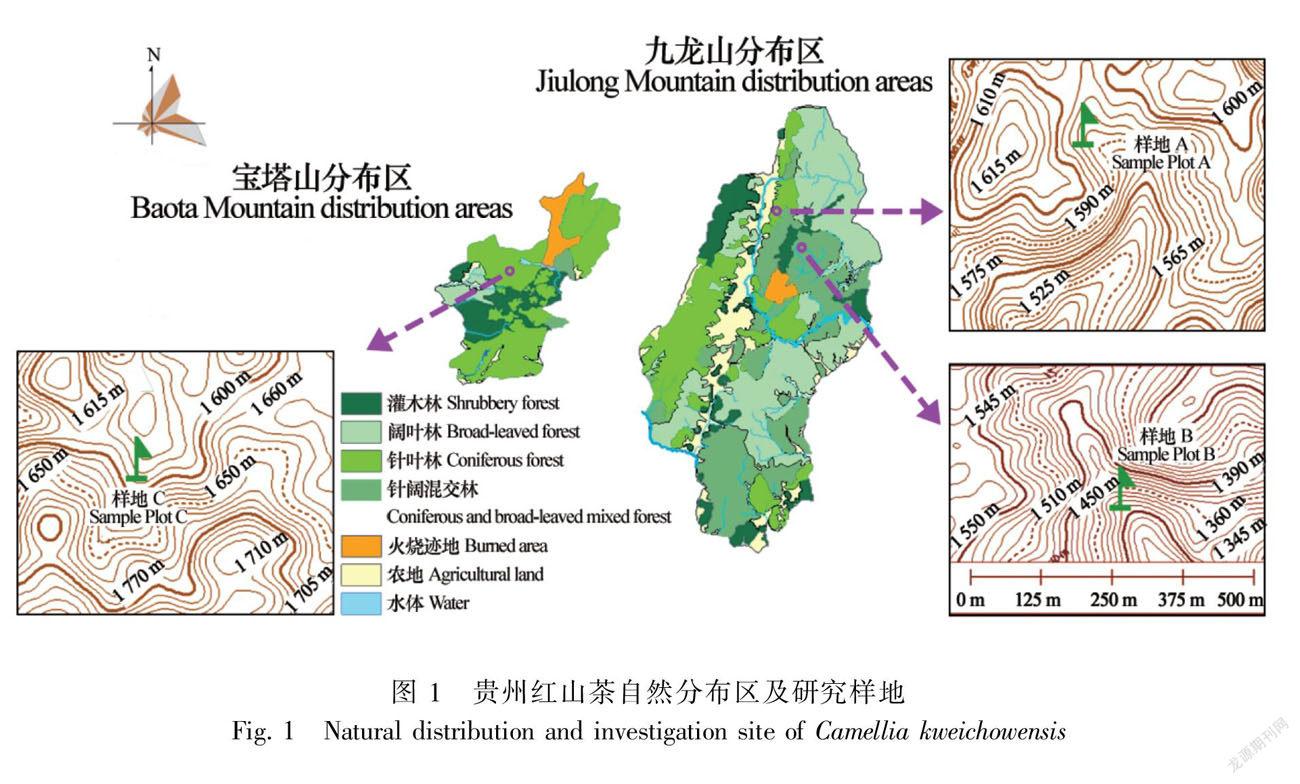
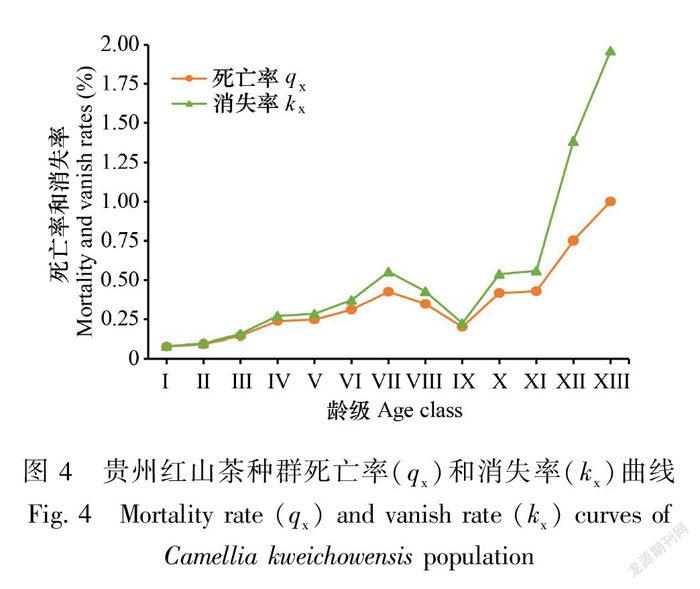

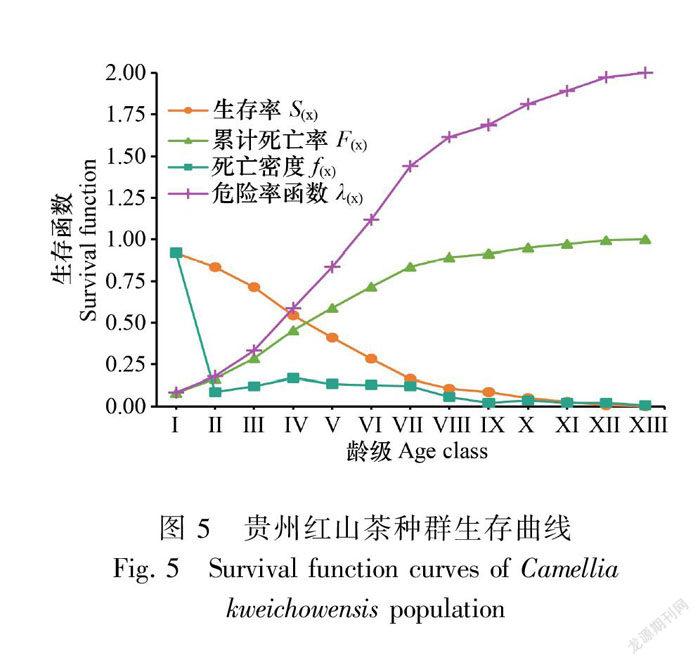
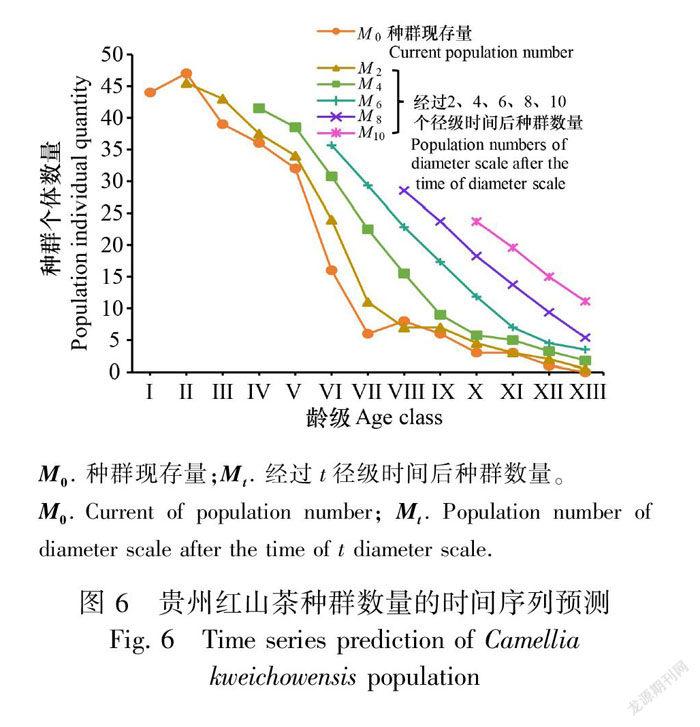
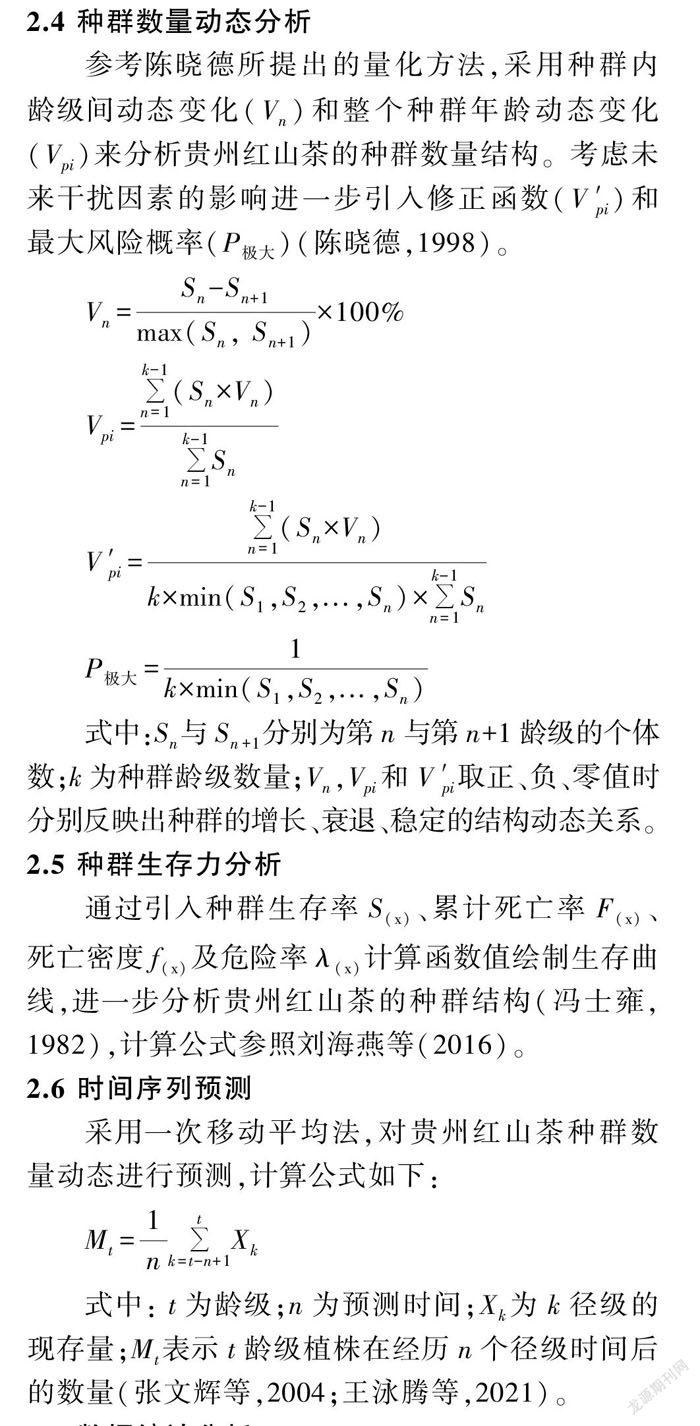





摘 要:貴州红山茶(Camellia kweichowensis)是红山茶组中稀有5室蒴果代表种之一,具有重要物种生物学意义和经济利用价值。为探索贵州红山茶物种稀有濒危原因,该文采用样方法与实测法调查,通过种群年龄结构和生存力分析,开展种群结构动态量化特征和未来发展趋势的研究。结果表明:(1)贵州红山茶原生植被具有亚热带湿润性常绿阔叶林典型特征,常绿落叶阔叶混交林占主体林分,华山松(Pinus armandii)+桦木(Betula luminifera)+枫香(Liquidambar formosana)+蓝果树(Nyssa sinensis)+山茶(Camellia sp.)+铃木(Eurya sp.)+木荷(Schima sp.)等针叶阔叶混交林常见。(2)贵州红山茶植物种群结构为增长型,以小树和中树龄级阶段植株为主体,占种群数量的73.02%;种群存活曲线Deevey-Ⅱ型特征明显,种群生命期望值在幼苗期达到最大值,死亡率和消失率曲线的变化趋势基本一致;种群幼苗库丰富但响应生境外的干扰敏感,幼苗存活至Ⅶ龄级植株概率陡降至36.17%,整体呈现“Ⅳ龄级前增长-Ⅳ龄级后衰退”的特点。(3)贵州红山茶在未来2、4、6、8、10个径级的生长期之后,种群动态趋于中树(Ⅴ~Ⅶ龄级)、大树(Ⅷ~Ⅹ龄级)和老树(Ⅺ~ⅩⅢ龄级)的态势。综上认为,贵州红山茶生境资源及空间有限性导致种群内部或不同物种间的竞争加剧,使种群幼苗存活率降低和低龄级植株数量减少,加上人类掠夺性采伐造成的成年植株死亡率增高,致使其种群的数量增加及种群扩散受阻,分布区狭窄,物种趋于濒危。
关键词: 贵州红山茶, 种群结构特征, 种群数量变化, 时间序列预测, 物种濒危机制
中图分类号:Q9458.15
文献标识码:A
文章编号:1000-3142(2022)03-0520-10
Population structure and dynamics analysis of rare
and endangered plant Camellia kweichowensis
TANG Feng1, ZOU Tiancai2, YANG Naikun3, HU Guangping4, LIU Haiyan5*
( 1. College of Forestry, Guizhou University, Guiyang 550025, China; 2. Guizhou Academy of Sciences, Guiyang 550001, China; 3. Guiyang
Zhongxiong Forestry Ecological Engineering Investigation & Design Co., Ltd., Guiyang 550004, China; 4. Institute for Natural Forest and Public
Welfare Forest Protection and Restoration of Guiyang, Guiyang 550003, China; 5. Guizhou Botanical Garden, Guiyang 550004, China )
Abstract:Camellia kweichowensis is a rare 5-locular capsule-bearing representative species of the section Camellia with biological importance and economic value. In order to explore the reasons for its endangered status, we studied the quantitative characteristics of population structure dynamics and future development trend by combining the sample investigation and actual measurement methods, the analysis of population age structure and survivability. The results were as follows: (1) The primary vegetation of C. kweichowensis had typical characteristics of subtropical humid evergreen broad-leaved forests. While the mixed evergreen and deciduous broad-leaved forest were the main stands, and the coniferous broad-leaved mixed forest of Pinus armandii + Betula luminifera + Liquidambar formosana + Nyssa sinensis + Camellia sp. + Eurya sp. + Schima sp. was common. (2) The growth population of C. kweichowensis dominated the growth structure. The points were mainly concentrated in the small and medium tree stages, and the sum of the proportion constituted 73.02% of the overall population. Deevey-Ⅱ type characteristic of the population survival curve was obvious, the life expectancy of C. kweichowensis was the maximum at the seedling stage. The change trend of mortality and the vanishing curves of the same plot were approximately the same. The quantitative dynamic analysis indicated that the three plots had abundant seedling pools, but were sensitive to the disturbance outside the habitat. The probability of surviving to Ⅶ age-class dropped significantly to 36.17%. On the whole, the population structure showed the characteristics of “growth in the early stage and decline in the late stage of Ⅳ age-class”. (3) After the growth period of 2, 4, 6, 8, and 10 diameter scales, the C. kweichowensis population dynamics tilted toward the succession of middle trees (Ⅴ-Ⅶ age-class), big trees (Ⅷ-Ⅹ age-class), and aged trees (Ⅺ-ⅩⅢ age-class). In conclusion, due to the limited habitat resources and space, intraspecific and interspecific competition intensifies, which reduces the survival rate of population seedlings and the number of young, and increased the mortality of adult plants caused by human predatory logging. As a result, the population renewal and diffusion are hindered, the distribution area is narrow, and the species tend to be endangered.
Key words: Camellia kweichowensis, population structure characteristics, population quantity change, time series prediction, species endangered mechanism
种群是物种进化的基本单位(姜在民等,2018),种群结构特征及其动态变化规律是种群生态学研究的核心内容和基础科学问题(王飞等,2022),种群生命表、生存分析、数量动态量化和时间序列预测等是研究植物种群数量特征的重要手段和工具(张文辉等,2004;张亚芳等,2015;朱强等,2019)。种群年龄结构能够反映种群数量配置变化规律,表现出种群植株在各个阶段的生长状况,可有效评估种群对生存环境的适应性(韩路等,2014;王泳腾等,2021)。数量动态量化和时间序列分析能够揭示种群动态变化特征及其潜在驱动机制(拓锋等,2021),是研究种群更新和扩散机制的基础,可为针对性地提出有效保护措施提供参考(罗西等,2021;赵家豪等,2022)。植物种群年龄结构及其数量动态的研究,已成为稀有濒危植物保护利用的科学基础。
贵州红山茶(Camellia kweichowensis)是山茶属植物红山茶组中少有子房5室的代表物种(张宏达,1981),常绿灌木或小乔木,树形优美,花冠直径4~12 cm、花色靓丽,颇具观赏特性和经济价值,分布于贵州省贵阳市百花湖乡九龙山森林植被区以及清镇市站街镇宝塔山天然林区的狭窄区域,贵州特有种(张宏达和任善湘,1998;鄒天才,2001)。目前,关于贵州红山茶植物资源调查评价(安明态,2005;张华海和班平原,2007)、土壤铝离子吸收、种子内含物检测(刘海燕等,2018)、种苗繁殖栽培(胡光平等,2013)等方面已有报道,但在贵州红山茶种群结构特征、数量动态变化规律、种群增长机制、有效保护利用途径的科学问题认知还严重缺失。本研究以贵州红山茶自然分布区为研究区域,依托其生境特征、植物区系成分组成以及贵州红山茶植物分布特点与种群结构的现实状况,采用样方法和实测法相结合的研究方法,通过贵州红山茶天然种群存活状况的实地调查及其种群结构组成与数量动态变化的研究,分析探讨了贵州红山茶种群的结构特征、数量动态变化规律、响应外界干扰适应性机制、物种濒危原因等科学问题,以期为贵州红山茶植物种质资源的有效保护与合理利用提供科学依据。
1 研究区概况
研究区位于贵州省贵阳市百花湖乡九龙山森林公园至站街镇宝塔山一带的森林植被区(106°23′48″-106°30′13″ E,26°36′12″-26°41′51″ N),属于亚热带季风湿润气候,年均降水1 317 mm,主要集中在5—8月;年平均温度13.9 ℃,最热月均温22.6 ℃,最冷月均温3.7 ℃,无霜期长达278 d;年均相对湿度82%左右,年平均日照时数1 087.9 h,地势起伏复杂多样,山区多雾,年均日照时数1 087.9 h,在春秋季节偶有低温冷害发生。分布区土壤主要有黄壤、黄棕壤和石灰土,黄壤为主要土壤类型,土层厚度多为40~60 cm,土壤pH值4.5~6.0。植被以常绿落叶阔叶混交林、落叶阔叶林、针叶阔叶混交林、灌丛植被为主体,次生性较强。
2 研究方法
2.1 调查方法和地点
采用样方法和实测法相结合开展调查(李苑菱,2017),选择贵州红山茶分布较为集中的林区,随机选取3个标准样地(样地A、样地B和样地C,见图1)。每个样地30 m×30 m,划分成9个10 m×10 m样方,总共2 700 m2。以10 m×10 m的样方为基础逐一调查贵州红山茶植株的基径和地理位置坐标。采用五点取样法在每个样地中取5个5 m×5 m的灌木样方,在灌木样方的中心位置取1 m×1 m的草本样方。采用“目测估计法”记录样地内物种乔木、灌木及草本植物种类及数量(杨持,2008)。其中,样地A位于高规(106°28′51″ E,26°40′12″ N,海拔1 588 m)、样地B在烂泥沟(106°28′52″ E,26°39′57″ N,海拔1 454 m),皆位于百花湖乡九龙山自然植被区内,样地C位于宝塔山北坡天然林保护区内(106°24′51″ E,26°39′22″ N,海拔1 636 m)。
2.2 种群龄级的划分

